Product Info Summary
| SKU: | A02359-2 |
|---|---|
| Size: | 100 μg/vial |
| Reactive Species: | Human, Mouse, Rat |
| Host: | Rabbit |
| Application: | Flow Cytometry, IHC, ICC, WB |
Customers Who Bought This Also Bought
Product info
Product Name
Anti-Nicotinic Acetylcholine Receptor alpha 5/CHRNA5 Antibody Picoband®
View all Nicotinic Acetylcholine R alpha 5/CHRNA5 Antibodies
SKU/Catalog Number
A02359-2
Size
100 μg/vial
Form
Lyophilized
Description
Boster Bio Anti-Nicotinic Acetylcholine Receptor alpha 5/CHRNA5 Antibody Picoband® catalog # A02359-2. Tested in Flow Cytometry, IHC, ICC, WB applications. This antibody reacts with Human, Mouse, Rat. The brand Picoband indicates this is a premium antibody that guarantees superior quality, high affinity, and strong signals with minimal background in Western blot applications. Only our best-performing antibodies are designated as Picoband, ensuring unmatched performance.
Storage & Handling
Store at -20˚C for one year from date of receipt. After reconstitution, at 4˚C for one month. It can also be aliquotted and stored frozen at -20˚C for six months. Avoid repeated freeze-thaw cycles.
Cite This Product
Anti-Nicotinic Acetylcholine Receptor alpha 5/CHRNA5 Antibody Picoband® (Boster Biological Technology, Pleasanton CA, USA, Catalog # A02359-2)
Host
Rabbit
Contents
Each vial contains 4mg Trehalose, 0.9mg NaCl, 0.2mg Na2HPO4, 0.05mg NaN3.
Clonality
Polyclonal
Isotype
Rabbit IgG
Immunogen
A synthetic peptide corresponding to a sequence at the N-terminus of human CHRNA5, different from the related mouse sequence by five amino acids, and from the related rat sequence by four amino acids.
*Blocking peptide can be purchased. Costs vary based on immunogen length. Contact us for pricing.
Cross-reactivity
No cross-reactivity with other proteins
Reactive Species
A02359-2 is reactive to CHRNA5 in Human, Mouse, Rat
Reconstitution
Add 0.2ml of distilled water will yield a concentration of 500ug/ml.
Observed Molecular Weight
53 kDa
Calculated molecular weight
53054 MW
Background of Nicotinic Acetylcholine R alpha 5/CHRNA5
Neuronal acetylcholine receptor subunit alpha-5 is a protein that in humans is encoded by the CHRNA5 gene. It is mapped to 15q25.1. The protein encoded by this gene is a nicotinic acetylcholine receptor subunit and a member of a superfamily of ligand-gated ion channels that mediate fast signal transmission at synapses. These receptors are thought to be heteropentamers composed of separate but similar subunits. Defects in this gene have been linked to susceptibility to lung cancer type 2 (LNCR2).
Antibody Validation
Boster validates all antibodies on WB, IHC, ICC, Immunofluorescence, and ELISA with known positive control and negative samples to ensure specificity and high affinity, including thorough antibody incubations.
Application & Images
Applications
A02359-2 is guaranteed for Flow Cytometry, IHC, ICC, WB Boster Guarantee
Assay Dilutions Recommendation
The recommendations below provide a starting point for assay optimization. The actual working concentration varies and should be decided by the user.
Immunohistochemistry (Paraffin-embedded Section), 0.5-1μg/ml, Human, Mouse, Rat, By Heat
Western blot, 0.1-0.5μg/ml, Human, Rat
Immunohistochemistry (Frozen Section), 0.5-1μg/ml, Human
Immunocytochemistry, 0.5-1μg/ml, Human
Flow Cytometry (Fixed), 1-3μg/1x106 cells, Human
Positive Control
WB: rat skeletal muscle tissue, HEPG2 whole cell
IHC: mouse intestine tissue, mouse cardiac muscle tissue, rat intestine tissue, rat cardiac muscle tissue, human prostatic cancer tissue
FCM: U251 cell, A549 cell, MCF-7 cell
Validation Images & Assay Conditions
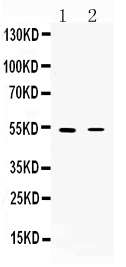
Click image to see more details
Figure 1. Western blot analysis of CHRNA5 using anti-CHRNA5 antibody (A02359-2).
Electrophoresis was performed on a 5-20% SDS-PAGE gel at 70V (Stacking gel) / 90V (Resolving gel) for 2-3 hours. The sample well of each lane was loaded with 50ug of sample under reducing conditions.
lane 1: rat skeletal muscle tissue lysates,
lane 2: HEPG2 whole cell lysates.
After Electrophoresis, proteins were transferred to a Nitrocellulose membrane at 150mA for 50-90 minutes. Blocked the membrane with 5% Non-fat Milk/ TBS for 1.5 hour at RT. The membrane was incubated with rabbit anti-CHRNA5 antigen affinity purified polyclonal antibody (Catalog # A02359-2) at 0.5 μg/mL overnight at 4°C, then washed with TBS-0.1%Tween 3 times with 5 minutes each and probed with a goat anti-rabbit IgG-HRP secondary antibody at a dilution of 1:10000 for 1.5 hour at RT. The signal is developed using an Enhanced Chemiluminescent detection (ECL) kit (Catalog # EK1002) with Tanon 5200 system. A specific band was detected for CHRNA5 at approximately 53KD. The expected band size for CHRNA5 is at 53KD.
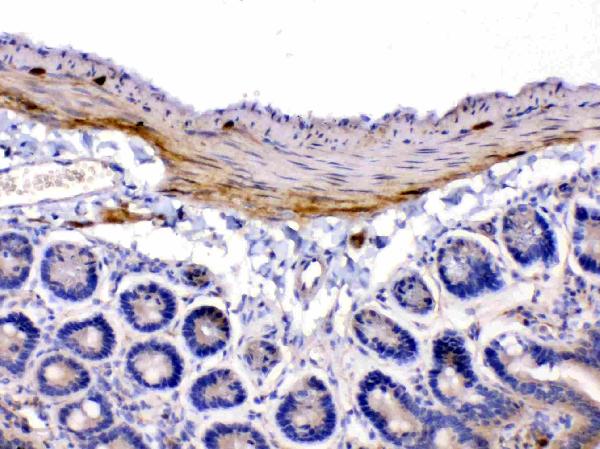
Click image to see more details
Figure 2. IHC analysis of CHRNA5 using anti-CHRNA5 antibody (A02359-2).
CHRNA5 was detected in paraffin-embedded section of mouse intestine tissues. Heat mediated antigen retrieval was performed in citrate buffer (pH6, epitope retrieval solution) for 20 mins. The tissue section was blocked with 10% goat serum. The tissue section was then incubated with 1μg/ml rabbit anti-FBXL4 Antibody (A02359-2) overnight at 4°C. Biotinylated goat anti-rabbit IgG was used as secondary antibody and incubated for 30 minutes at 37°C. The tissue section was developed using Strepavidin-Biotin-Complex (SABC)(Catalog # SA1022) with DAB as the chromogen.
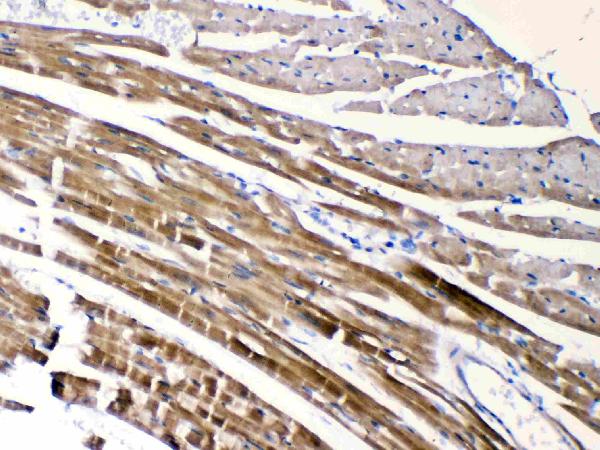
Click image to see more details
Figure 3. IHC analysis of CHRNA5 using anti-CHRNA5 antibody (A02359-2).
CHRNA5 was detected in paraffin-embedded section of mouse cardiac muscle tissues. Heat mediated antigen retrieval was performed in citrate buffer (pH6, epitope retrieval solution) for 20 mins. The tissue section was blocked with 10% goat serum. The tissue section was then incubated with 1μg/ml rabbit anti-CHRNA5 Antibody (A02359-2) overnight at 4°C. Biotinylated goat anti-rabbit IgG was used as secondary antibody and incubated for 30 minutes at 37°C. The tissue section was developed using Strepavidin-Biotin-Complex (SABC)(Catalog # SA1022) with DAB as the chromogen.
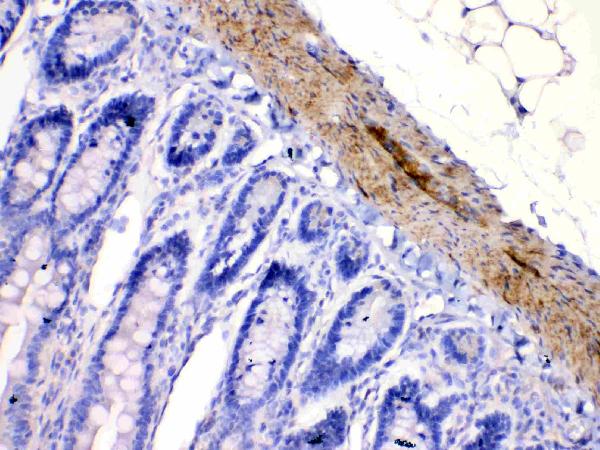
Click image to see more details
Figure 4. IHC analysis of CHRNA5 using anti-CHRNA5 antibody (A02359-2).
CHRNA5 was detected in paraffin-embedded section of rat intestine tissues. Heat mediated antigen retrieval was performed in citrate buffer (pH6, epitope retrieval solution) for 20 mins. The tissue section was blocked with 10% goat serum. The tissue section was then incubated with 1μg/ml rabbit anti-CHRNA5 Antibody (A02359-2) overnight at 4°C. Biotinylated goat anti-rabbit IgG was used as secondary antibody and incubated for 30 minutes at 37°C. The tissue section was developed using Strepavidin-Biotin-Complex (SABC)(Catalog # SA1022) with DAB as the chromogen.
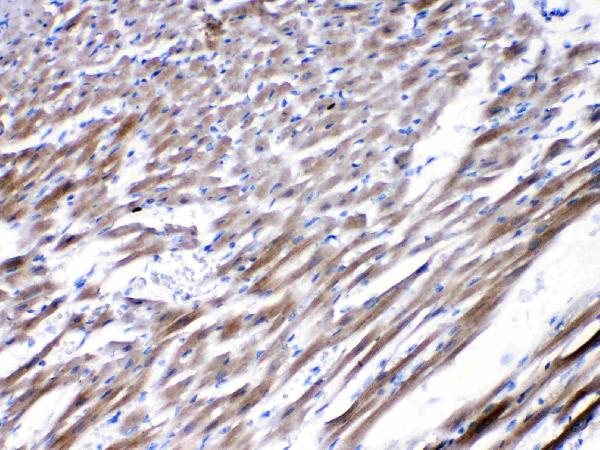
Click image to see more details
Figure 5. IHC analysis of CHRNA5 using anti-CHRNA5 antibody (A02359-2).
CHRNA5 was detected in paraffin-embedded section of rat cardiac muscle tissues. Heat mediated antigen retrieval was performed in citrate buffer (pH6, epitope retrieval solution) for 20 mins. The tissue section was blocked with 10% goat serum. The tissue section was then incubated with 1μg/ml rabbit anti-FBXL4 Antibody (A02359-2) overnight at 4°C. Biotinylated goat anti-rabbit IgG was used as secondary antibody and incubated for 30 minutes at 37°C. The tissue section was developed using Strepavidin-Biotin-Complex (SABC)(Catalog # SA1022) with DAB as the chromogen.
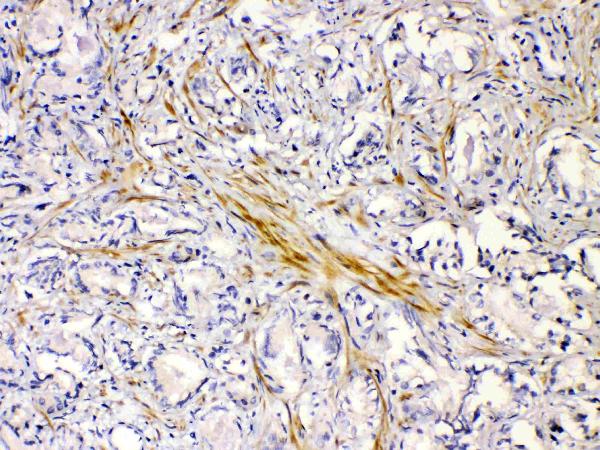
Click image to see more details
Figure 6. IHC analysis of CHRNA5 using anti-CHRNA5 antibody (A02359-2).
CHRNA5 was detected in paraffin-embedded section of human prostatic cancer tissues. Heat mediated antigen retrieval was performed in citrate buffer (pH6, epitope retrieval solution) for 20 mins. The tissue section was blocked with 10% goat serum. The tissue section was then incubated with 1μg/ml rabbit anti-CHRNA5 Antibody (A02359-2) overnight at 4°C. Biotinylated goat anti-rabbit IgG was used as secondary antibody and incubated for 30 minutes at 37°C. The tissue section was developed using Strepavidin-Biotin-Complex (SABC)(Catalog # SA1022) with DAB as the chromogen.
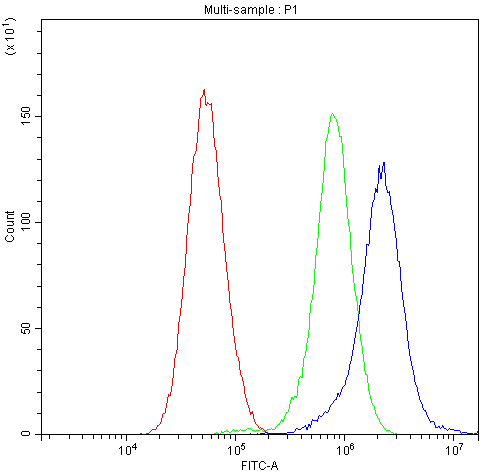
Click image to see more details
Figure 7. Flow Cytometry analysis of U251 cells using anti-CHRNA5 antibody (A02359-2).
Overlay histogram showing U251 cells stained with A02359-2 (Blue line). To facilitate intracellular staining, cells were fixed with 4% paraformaldehyde and permeabilized with permeabilization buffer. The cells were blocked with 10% normal goat serum. And then incubated with rabbit anti-CHRNA5 Antibody (A02359-2,1μg/1x106 cells) for 30 min at 20°C. DyLight®488 conjugated goat anti-rabbit IgG (BA1127, 5-10μg/1x106 cells) was used as secondary antibody for 30 minutes at 20°C. Isotype control antibody (Green line) was rabbit IgG (1μg/1x106) used under the same conditions. Unlabelled sample without incubation with primary antibody and secondary antibody (Red line) was used as a blank control.
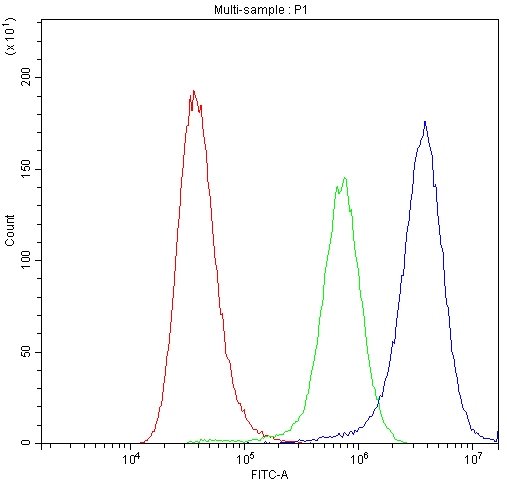
Click image to see more details
Figure 8. Flow Cytometry analysis of A549 cells using anti-CHRNA5 antibody (A02359-2).
Overlay histogram showing A549 cells stained with A02359-2 (Blue line). To facilitate intracellular staining, cells were fixed with 4% paraformaldehyde and permeabilized with permeabilization buffer. The cells were blocked with 10% normal goat serum. And then incubated with rabbit anti-CHRNA5 Antibody (A02359-2,1μg/1x106 cells) for 30 min at 20°C. DyLight®488 conjugated goat anti-rabbit IgG (BA1127, 5-10μg/1x106 cells) was used as secondary antibody for 30 minutes at 20°C. Isotype control antibody (Green line) was rabbit IgG (1μg/1x106) used under the same conditions. Unlabelled sample without incubation with primary antibody and secondary antibody (Red line) was used as a blank control.
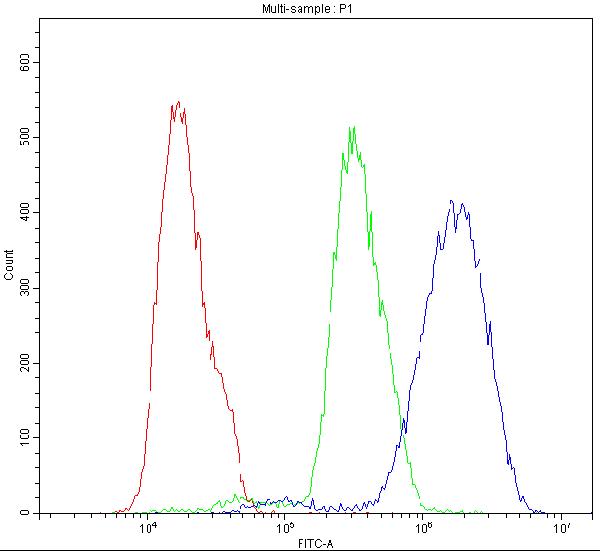
Click image to see more details
Figure 9. Flow Cytometry analysis of MCF-7 cells using anti-CHRNA5 antibody (A02359-2).
Overlay histogram showing MCF-7 cells stained with A02359-2 (Blue line). To facilitate intracellular staining, cells were fixed with 4% paraformaldehyde and permeabilized with permeabilization buffer. The cells were blocked with 10% normal goat serum. And then incubated with rabbit anti-CHRNA5 Antibody (A02359-2,1μg/1x106 cells) for 30 min at 20°C. DyLight®488 conjugated goat anti-rabbit IgG (BA1127, 5-10μg/1x106 cells) was used as secondary antibody for 30 minutes at 20°C. Isotype control antibody (Green line) was rabbit IgG (1μg/1x106) used under the same conditions. Unlabelled sample without incubation with primary antibody and secondary antibody (Red line) was used as a blank control.
Protein Target Info & Infographic
Gene/Protein Information For CHRNA5 (Source: Uniprot.org, NCBI)
Gene Name
CHRNA5
Full Name
Neuronal acetylcholine receptor subunit alpha-5
Weight
53054 MW
Superfamily
ligand-gated ion channel (TC 1.A.9) family
Alternative Names
Neuronal acetylcholine receptor subunit alpha-5;CHRNA5;NACHRA5; CHRNA5 LNCR2 cholinergic receptor nicotinic alpha 5 subunit neuronal acetylcholine receptor subunit alpha-5|Cholinergic receptor, neuronal nicotinic, alpha polypeptide-5|acetylcholine receptor, nicotinic, alpha 5 (neuronal)|cholinergic receptor, nicotinic alpha 5|cholinergic receptor, nicotinic, alpha 5 (neuronal)|neuronal nicotinic acetylcholine receptor, alpha5 subunit
*If product is indicated to react with multiple species, protein info is based on the gene entry specified above in "Species".For more info on CHRNA5, check out the CHRNA5 Infographic

We have 30,000+ of these available, one for each gene! Check them out.
In this infographic, you will see the following information for CHRNA5: database IDs, superfamily, protein function, synonyms, molecular weight, chromosomal locations, tissues of expression, subcellular locations, post-translational modifications, and related diseases, research areas & pathways. If you want to see more information included, or would like to contribute to it and be acknowledged, please contact [email protected].
Specific Publications For Anti-Nicotinic Acetylcholine Receptor alpha 5/CHRNA5 Antibody Picoband® (A02359-2)
Hello CJ!
A02359-2 has been cited in 5 publications:
*The publications in this section are manually curated by our staff scientists. They may differ from Bioz's machine gathered results. Both are accurate. If you find a publication citing this product but is missing from this list, please let us know we will issue you a thank-you coupon.
Differential Expression of Nicotine Acetylcholine Receptors Associates with Human Breast Cancer and Mediates Antitumor Activity of αO-Conotoxin GeXIVA
Cervical Cancer Correlates with the Differential Expression of Nicotinic Acetylcholine Receptors and Reveals Therapeutic Targets
Identification of nicotinic acetylcholine receptor subunits in different lung cancer cell lines and the inhibitory effect of alpha-conotoxin TxID on lung cancer cell growth
Su Y,Ahn B,Macpherson PCD,Ranjit R,Claflin DR,Van Remmen H,Brooks SV.Transgenic expression of SOD1 specifically in neurons of Sod1 deficient mice prevents defects in muscle mitochondrial function and calcium handling.Free Radic Biol Med.2021 Feb 6:S0891-5
Species: Mouse
A02359-2 usage in article: APP:WB, SAMPLE:LIVER,MUSCLE AND SPINAL CORD, DILUTION:1:1000
Sun Z,Zhangsun M,Dong S,Liu Y,Qian J,Zhangsun D,Luo S.Differential Expression of Nicotine Acetylcholine Receptors Associates with Human Breast Cancer and Mediates Antitumor Activity of αO-Conotoxin GeXIVA.Mar Drugs.2020 Jan 17;18(1):61.doi:10.3390/md18010
Species: Human
A02359-2 usage in article: APP:FLOW CYTOMETRY, SAMPLE:BREAST CANCER CELL LINES, DILUTION:NA
Recommended Resources
Here are featured tools and databases that you might find useful.
- Boster's Pathways Library
- Protein Databases
- Bioscience Research Protocol Resources
- Data Processing & Analysis Software
- Photo Editing Software
- Scientific Literature Resources
- Research Paper Management Tools
- Molecular Biology Software
- Primer Design Tools
- Bioinformatics Tools
- Phylogenetic Tree Analysis
Customer Reviews
Have you used Anti-Nicotinic Acetylcholine Receptor alpha 5/CHRNA5 Antibody Picoband®?
Submit a review and receive an Amazon gift card.
- $30 for a review with an image
0 Reviews For Anti-Nicotinic Acetylcholine Receptor alpha 5/CHRNA5 Antibody Picoband®
Customer Q&As
Have a question?
Find answers in Q&As, reviews.
Can't find your answer?
Submit your question
5 Customer Q&As for Anti-Nicotinic Acetylcholine Receptor alpha 5/CHRNA5 Antibody Picoband®
Question
My question regarding product A02359-2, anti-Nicotinic Acetylcholine Receptor alpha 5/CHRNA5 antibody. I was wondering if it would be possible to conjugate this antibody with biotin. I would need it to be without BSA or sodium azide. I am planning on using a buffer exchange of sodium azide with PBS only. Would there be problems for me to conjugate the antibody and store it in -20 degrees in small aliquots?
N. Evans
Verified customer
Asked: 2020-03-18
Answer
We do not recommend storing this antibody with PBS buffer only in -20 degrees. If you want to store it in -20 degrees it is best to add some cryoprotectant like glycerol. If you want carrier free A02359-2 anti-Nicotinic Acetylcholine Receptor alpha 5/CHRNA5 antibody, we can provide it to you in a special formula with trehalose and/or glycerol. These molecules will not interfere with conjugation chemistry and provide a good level of protection for the antibody from degradation. Please be sure to specify this in your purchase order.
Boster Scientific Support
Answered: 2020-03-18
Question
See attached the WB image, lot number and protocol we used for testis using anti-Nicotinic Acetylcholine Receptor alpha 5/CHRNA5 antibody A02359-2. Please let me know if you require anything else.
Verified Customer
Verified customer
Asked: 2020-01-10
Answer
Thank you very much for the data. Our lab team are working to resolve this as quickly as possible, and we appreciate your patience and understanding! You have provided everything we needed. Please let me know if there is anything you need in the meantime.
Boster Scientific Support
Answered: 2020-01-10
Question
We appreciate helping with my inquiry over the phone. Here are the WB image, lot number and protocol we used for testis using anti-Nicotinic Acetylcholine Receptor alpha 5/CHRNA5 antibody A02359-2. Let me know if you need anything else.
Verified Customer
Verified customer
Asked: 2018-08-15
Answer
Thank you for the data. You have provided everything we needed. Our lab team are working to resolve your inquiry as quickly as possible, and we appreciate your patience and understanding! Please let me know if there is anything you need in the meantime.
Boster Scientific Support
Answered: 2018-08-15
Question
We are currently using anti-Nicotinic Acetylcholine Receptor alpha 5/CHRNA5 antibody A02359-2 for human tissue, and we are content with the IHC results. The species of reactivity given in the datasheet says human, mouse, rat. Is it likely that the antibody can work on bovine tissues as well?
R. Mitchell
Verified customer
Asked: 2014-08-15
Answer
The anti-Nicotinic Acetylcholine Receptor alpha 5/CHRNA5 antibody (A02359-2) has not been tested for cross reactivity specifically with bovine tissues, but there is a good chance of cross reactivity. We have an innovator award program that if you test this antibody and show it works in bovine you can get your next antibody for free. Please contact me if I can help you with anything.
Boster Scientific Support
Answered: 2014-08-15
Question
Would anti-Nicotinic Acetylcholine Receptor alpha 5/CHRNA5 antibody A02359-2 work on canine Flow Cytometry with testis?
A. Bhatt
Verified customer
Asked: 2014-03-26
Answer
Our lab technicians have not validated anti-Nicotinic Acetylcholine Receptor alpha 5/CHRNA5 antibody A02359-2 on canine. You can run a BLAST between canine and the immunogen sequence of anti-Nicotinic Acetylcholine Receptor alpha 5/CHRNA5 antibody A02359-2 to see if they may cross-react. If the sequence homology is close, then you can perform a pilot test. Keep in mind that since we have not validated canine samples, this use of the antibody is not covered by our guarantee. However we have an innovator award program that if you test this antibody and show it works in canine testis in Flow Cytometry, you can get your next antibody for free.
Boster Scientific Support
Answered: 2014-03-26





